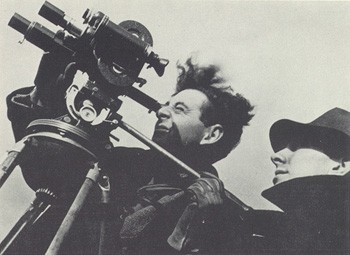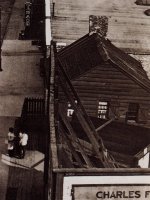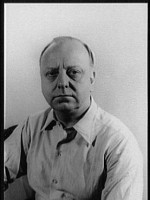Ralph Steiner est un Réalisateur, Directeur de la Photographie, Monteur et Cinématographie Américain né le 8 février 1899 à Cleveland (Etats-Unis)

Ralph Steiner (February 8, 1899 – July 13, 1986) was an American photographer, pioneer documentarian and a key figure among avant-garde filmmakers in the 1930s.
In 1929, Steiner made his first film, H2O, a poetic evocation of water that captured the abstract patterns generated by waves. Although it was not the only film of its kind at the time – Joris Ivens made Regen (Rain) that same year, and Henwar Rodekiewicz worked on his similar film Portrait of a Young Man (1931) through this whole period – it made a significant impression in its day and since has become recognized as a classic: H2O was added to the National Film Registry in December 2005. Among Steiner's other early films, Surf and Seaweed (1931) expands on the concept of H2O as Steiner turns his camera to the shoreline; Mechanical Principles (1933) was an abstraction based on gears and machinery.
In 1930, Steiner joined the faculty of the so-called Harry Alan Potamkin Film School, which folded shortly before Potamkin's death in 1933; there he met Leo Hurwitz and, inspired by Hurwitz' ideas of utilizing film as a means of social action, left the Film and Photo League and joined Nykino, a loose coalition of New York based cinematographers who pooled footage for use in left-wing newsreels shown at worker's rallies, conventions and during strikes. Precious few of these films have survived, most being destroyed in a warehouse fire in 1935. During this time Steiner also worked on some topical, fictional "pool" film satires, including Pie in the Sky (1935), the earliest film to involve the talents of Elia Kazan.
Steiner spent summers at the Pine Brook Country Club located in the countryside of Nichols, Connecticut, which became the summer rehearsal headquarters of the Group Theatre (New York) working with Felicia Sorel and Gluck Sandor among others.
Steiner worked, alongside Strand, Hurwitz and Paul Ivano as a cinematographer on Pare Lorentz' The Plow That Broke the Plains (1936) and likewise joined Lorentz on The River (1938) but did not receive credit. Although Steiner remained with Nykino throughout their transition into Frontier Films, he left in 1938, taking the footage of The City (1939) with him. The City, which Steiner co-directed with Willard Van Dyke and featuring original music by Aaron Copland, opened at the New York World's Fair in 1939 and ran for two years. Henwar Rodakiewicz moved from Los Angeles in August, 1938 to assist Steiner in the production of The City, contributing his editing, writing, and organizational skills to the project.
Despite his own stated disdain of Hollywood and the shared sentiments of his colleagues, in the 1940s Steiner went to Hollywood to work as a writer-producer, but returned to New York after only four years spent there. Then he plunged back into the world of freelance and fashion photography, working for Vogue, Look Magazine and others before retiring in 1962. Steiner then settled in Vermont, where he spent summers on a Maine island.
Source : Wikidata
Ralph Steiner

- Infos
- Photos
- Meilleurs films
- Famille
- Personnages
- Récompenses
Nom de naissance Ralph Steiner
Nationalité Etats-Unis
Naissance 8 février 1899 à Cleveland (Etats-Unis)
Mort 13 juillet 1986 (à 87 ans)
Récompenses Bourse Guggenheim
Nationalité Etats-Unis
Naissance 8 février 1899 à Cleveland (Etats-Unis)
Mort 13 juillet 1986 (à 87 ans)
Récompenses Bourse Guggenheim
Biographie
Born in Cleveland, Steiner studied chemistry at Dartmouth, but in 1921 entered the Clarence H. White School of Modern Photography. White helped Steiner in finding a job at the Manhattan Photogravure Company, and Steiner worked on making photogravure plates of scenes from Robert Flaherty's Nanook of the North. Not long after, Steiner's work as a freelance photographer in New York began, working mostly in advertising and for publications like Ladies' Home Journal. Through the encouragement of fellow photographer Paul Strand, Steiner joined the left-of-center Film and Photo League around 1927. He was also to influence the photography of Walker Evans, giving him guidance, technical assistance, and one of his view cameras.In 1929, Steiner made his first film, H2O, a poetic evocation of water that captured the abstract patterns generated by waves. Although it was not the only film of its kind at the time – Joris Ivens made Regen (Rain) that same year, and Henwar Rodekiewicz worked on his similar film Portrait of a Young Man (1931) through this whole period – it made a significant impression in its day and since has become recognized as a classic: H2O was added to the National Film Registry in December 2005. Among Steiner's other early films, Surf and Seaweed (1931) expands on the concept of H2O as Steiner turns his camera to the shoreline; Mechanical Principles (1933) was an abstraction based on gears and machinery.
In 1930, Steiner joined the faculty of the so-called Harry Alan Potamkin Film School, which folded shortly before Potamkin's death in 1933; there he met Leo Hurwitz and, inspired by Hurwitz' ideas of utilizing film as a means of social action, left the Film and Photo League and joined Nykino, a loose coalition of New York based cinematographers who pooled footage for use in left-wing newsreels shown at worker's rallies, conventions and during strikes. Precious few of these films have survived, most being destroyed in a warehouse fire in 1935. During this time Steiner also worked on some topical, fictional "pool" film satires, including Pie in the Sky (1935), the earliest film to involve the talents of Elia Kazan.
Steiner spent summers at the Pine Brook Country Club located in the countryside of Nichols, Connecticut, which became the summer rehearsal headquarters of the Group Theatre (New York) working with Felicia Sorel and Gluck Sandor among others.
Steiner worked, alongside Strand, Hurwitz and Paul Ivano as a cinematographer on Pare Lorentz' The Plow That Broke the Plains (1936) and likewise joined Lorentz on The River (1938) but did not receive credit. Although Steiner remained with Nykino throughout their transition into Frontier Films, he left in 1938, taking the footage of The City (1939) with him. The City, which Steiner co-directed with Willard Van Dyke and featuring original music by Aaron Copland, opened at the New York World's Fair in 1939 and ran for two years. Henwar Rodakiewicz moved from Los Angeles in August, 1938 to assist Steiner in the production of The City, contributing his editing, writing, and organizational skills to the project.
Despite his own stated disdain of Hollywood and the shared sentiments of his colleagues, in the 1940s Steiner went to Hollywood to work as a writer-producer, but returned to New York after only four years spent there. Then he plunged back into the world of freelance and fashion photography, working for Vogue, Look Magazine and others before retiring in 1962. Steiner then settled in Vermont, where he spent summers on a Maine island.
Le plus souvent avec
Filmographie de Ralph Steiner (3 films)
Réalisateur
Caméraman
 , 25minutes
, 25minutesRéalisé par Pare Lorentz
Origine Etats-Unis
Genres Documentaire
Thèmes L'environnement, Documentaire sur le monde des affaires, Documentaire sur l'environnement
Acteurs Thomas Chalmers
Rôle Directeur de la Photographie
Note61%






H2O (1929)
, 13minutesRéalisé par Ralph Steiner
Origine Etats-Unis
Genres Documentaire
Rôle Directeur de la Photographie
Note68%





Monteur

H2O (1929)
, 13minutesRéalisé par Ralph Steiner
Origine Etats-Unis
Genres Documentaire
Rôle Monteur
Note68%





Equipe

People of the Cumberland (1937)
, 18minutesRéalisé par Elia Kazan, Sidney Meyers
Origine Etats-Unis
Genres Documentaire
Thèmes Le monde du travail, Documentaire sur la politique, Politique
Rôle Cinématographie
Note69%





The film takes place in rural Tennessee, where communities have experienced economic and environmental devastation created by the coal mining industry. The introduction of the Highlander Folk School in 1931 by educator Myles Horton and the movement to bring labor union representation to the region are shown as means of empowering the population. Efforts are made to stop the union activities with the murder of a local organizer, but eventually the union movement is able to take root with the local workforce.
 , 25minutes
, 25minutesRéalisé par Pare Lorentz
Origine Etats-Unis
Genres Documentaire
Thèmes L'environnement, Documentaire sur le monde des affaires, Documentaire sur l'environnement
Acteurs Thomas Chalmers
Rôle Cinématographie
Note61%





 Connexion
Connexion




